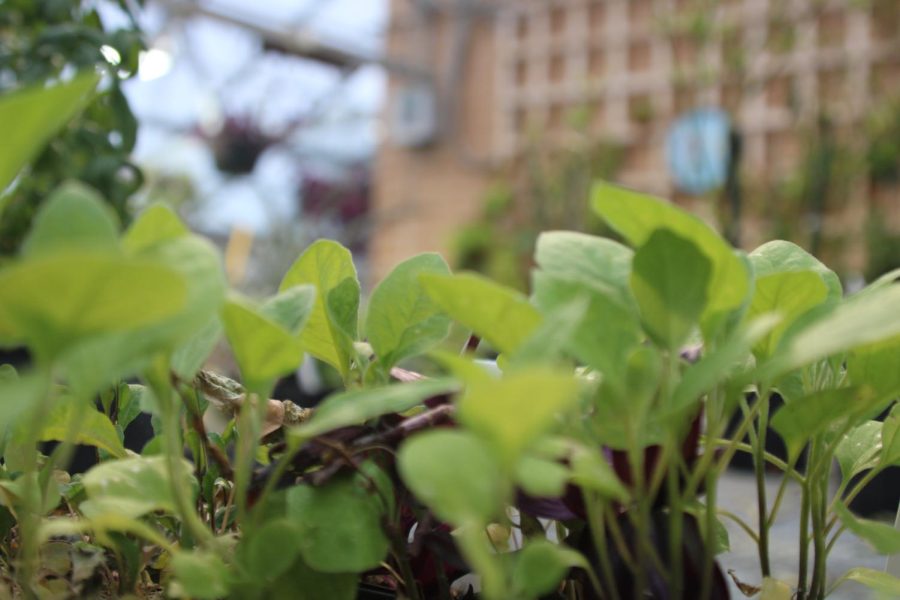Self-sufficiency latest trend in helping the environment
From gardens to van life, society is looking for new ways to exist
Our horticulture classes teach students how to grow plants.
April 14, 2023
When people begin to focus on self-sufficiency, they no longer need to rely on others for survival. Being profoundly self-sufficient allows one to be entirely independent in their skills, what they eat, and how they live. This leads to feelings of contentment as well as security in the environment we live in.
Throughout history, agricultural self-sufficiency has seen a significant increase as the amount of people choosing to be environmentally independent has grown. Interest in home gardening has seen a significant rise over the past few years, as about 42% of Americans have decided to begin growing their own produce.
One of the good things that the experience of the COVID-19 pandemic has done for society is encourage people to make their own food while stuck at home. Thanks to the outbreak of COVID, Americans were forced to stay at home, where they realized that growing their own food can be entirely beneficial.
Gardening and growing your own food and produce has many benefits. As the price of food is consistently rising, independently providing food has started to become much more affordable.
The average cost for fruits and vegetables seems to rise each year, and by growing your own, you are able to save up a significant amount of money that you would be spending on these produce items. In addition to saving money on foods like vegetables, growing your own food allows consumers to control pesticides and different harmful chemicals that can touch their food in grocery stores.
More than 70% of non-organic produce sold in stores contains harmful pesticides, most commonly seen in foods such as apples, strawberries, and grapes. By growing food independent of grocery stores, it is much easier to get rid of these common toxins present on our everyday foods.
Self-sufficiency has amazing environmental benefits as well. Some people may not realize the impact that purchasing these foods from the grocery store has on the environment. By growing our own foods and becoming less reliant on stores, we are able to produce fewer transportation emissions.
If the amount of food we purchase decreases, travel and processing also decreases. Because of this, we are not as reliant on fossil fuels to provide us with the healthy foods needed
to survive. Creating a self-sufficient world will minimize carbon pollution, and as a result, our carbon footprints will be reduced.
The demand for fossil fuel power will significantly decrease as a result of growing our own food and focusing on more renewable energy sources.
An example of this is using solar power, which is integral in reducing greenhouse gas emissions. Using solar energy helps the environment significantly in small ways that usually go unnoticed. Relying on solar energy can improve air quality and improve water conservation in order to protect humans as well as wildlife. In the US, the solar power industry has grown, on average, 20.7% per year in the past five years. Fortunately, as humans have become more self-sufficient, they are in turn starting to focus on the use of renewable resources including solar power.
Something that has become increasingly popular throughout society is what is known as “van life.” This is when people choose to live their life solely inside a mobile van. Usually, the goal is to travel while saving as many carbon emissions as possible. Living in a van is essentially like living outside, as less electricity and fuel are needed to survive. In addition, vans can run on solar power, which is fuel-efficient and extremely environmentally friendly.
A common thing to do is to install solar panels on vans in order to make the living situation as sustainable as possible. These are self-sufficient qualities that allow people to become more dedicated to their own survival and less reliant on outside resources such as grocery stores. This lifestyle has become popular as more people have begun to realize its environmental and financial benefits.
Other lifestyles that are becoming increasingly popular and are environmentally friendly include living in “tiny homes” and spending your time traveling the country and working remotely inside recreational vehicles.
Our government also is moving toward more electric-powered cars to leave less of a carbon footprint with less reliance on gasoline that comes from drilling for oil.
Living sustainably in ways such as this can allow us to access new learning opportunities about the environment. Because we are consistently using fewer resources, our environment will simultaneously benefit. Through fewer carbon emissions, fossil fuels, and pesticides being used, the environment will thank us for living self-sufficiently.














